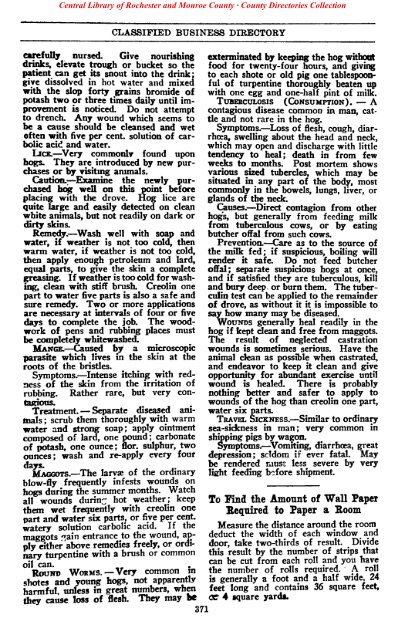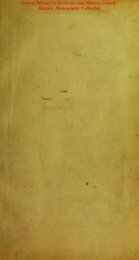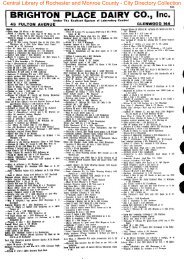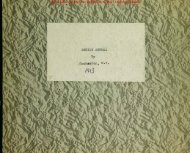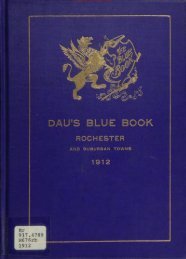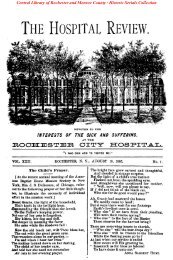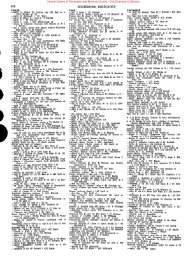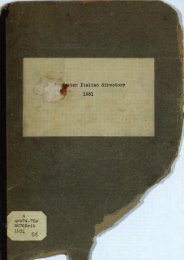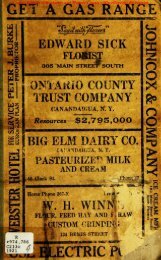The Farm Journal Illustrated Rural Directory of Monroe County, New ...
The Farm Journal Illustrated Rural Directory of Monroe County, New ...
The Farm Journal Illustrated Rural Directory of Monroe County, New ...
You also want an ePaper? Increase the reach of your titles
YUMPU automatically turns print PDFs into web optimized ePapers that Google loves.
Central Library <strong>of</strong> Rochester and <strong>Monroe</strong> <strong>County</strong> · <strong>County</strong> Directories Collection<br />
CLASSIFIED BUSINESS DIRECTORY<br />
carefully nursed Give nourishing<br />
drinks, elevate trough or bucket so the<br />
patient can get its snout into the drink;<br />
give dissolved in hot water and mixed<br />
with the slop forty grains bromide <strong>of</strong><br />
potash two or three times daily until improvement<br />
is noticed. Do not attempt<br />
to drench. Any wound which seems to<br />
be a cause should be cleansed and wet<br />
<strong>of</strong>ten with five per cent, solution <strong>of</strong> carbolic<br />
acid and water.<br />
LICE.—Very commonly found upon<br />
hogs. <strong>The</strong>y are introduced by new purchases<br />
or by visiting animals.<br />
Caution.—Examine the newly purchased<br />
hog well on this point before<br />
placing with the drove. Hog lice are<br />
quite large and easily detected on clean<br />
white animals, but not readily on dark or<br />
dirty skins.<br />
Remedy.—Wash well with soap and<br />
water, if weather is not too cold, then<br />
warm water, if weather is not too cold,<br />
then apply enough petroleum and lard,<br />
equal parts, to give the skin a complete<br />
greasing. If weather is too cold for washing,<br />
clean with stiff brush. Creolin one<br />
part to water five parts is also a safe and<br />
sure remedy. Two or more applications<br />
are necessary at intervals <strong>of</strong> four or five<br />
days to complete the job. <strong>The</strong> woodwork<br />
<strong>of</strong> pens and rubbing places must<br />
be completely whitewashed.<br />
MANGE.—Caused by a microscopic<br />
parasite which lives in the skin at the<br />
roots <strong>of</strong> the bristles.<br />
Symptoms.—Intense itching with redness<br />
<strong>of</strong> the skin from the irritation <strong>of</strong><br />
rubbing. Rather rare, but very contagious.<br />
Treatment. — Separate diseased animals<br />
; scrub them thoroughly with warm<br />
water and strong soap; apply ointment<br />
composed <strong>of</strong> lard, one pound; carbonate<br />
<strong>of</strong> potash, one ounce; flor. sulphur, two<br />
ounces; wash and re-apply every four<br />
days.<br />
MAGGOTS.—<strong>The</strong> larvae <strong>of</strong> the ordinary<br />
blow-fly frequently infests wounds on<br />
hogs during the summer months. Watch<br />
all wounds during hot weather; keep<br />
them wet frequently with creolin one<br />
part and water six parts, or five per cent,<br />
watery solution carbolic acid. If the<br />
maggots ^ain entrance to the wound, apply<br />
either above remedies freely, or ordinary<br />
turpentine with a brush or common<br />
oil can.<br />
ROUND WORMS.—Very common in<br />
shotes and voung hogs, not apparently<br />
harmful, unless in great numbers, when<br />
they cause loss <strong>of</strong> flesh. <strong>The</strong>y may be<br />
371<br />
exterminated by keeping the hog without<br />
food for twenty-four hours, and giving<br />
to each shote or old pig one tablespoonful<br />
<strong>of</strong> turpentine thoroughly beaten up<br />
with one egg and one-half pint <strong>of</strong> milk.<br />
TUBERCULOSIS (CONSUMPTION). — A<br />
contagious disease common in man, cattle<br />
and not rare in the hog.<br />
Symptoms.—Loss <strong>of</strong> flesh, cough, diarrhoea,<br />
swelling about the head and neck,<br />
which may open and discharge with little<br />
tendency to heal; death in from few<br />
weeks to months. Post mortem shows<br />
various sized tubercles, which may be<br />
situated in any part <strong>of</strong> the body, most<br />
commonly in the bowels, lungs, liver, or<br />
glands <strong>of</strong> the neck.<br />
Causes.—Direct contagion from other<br />
hogs, but generally from feeding milk<br />
from tuberculous cows, or by eating<br />
butcher <strong>of</strong>fal from such cows.<br />
Prevention.—Care as to the source <strong>of</strong><br />
the milk fed; if suspicious, boiling will<br />
render it safe. Do not feed butcher<br />
<strong>of</strong>fal; separate suspicious hogs at once,<br />
and if satisfied they are tuberculous, kill<br />
and bury deep, or burn them. <strong>The</strong> tuberculin<br />
test can be applied to the remainder<br />
<strong>of</strong> drove, as without it it is impossible to<br />
say how many may be diseased.<br />
WOUNDS generally heal readily in the<br />
hog if kept dean and free from maggots.<br />
<strong>The</strong> result <strong>of</strong> neglected castration<br />
wounds is sometimes serious. Have the<br />
animal clean as possible when castrated,<br />
and endeavor to keep it clean and give<br />
opportunity for abundant exercise until<br />
wound is healed. <strong>The</strong>re is probably<br />
nothing better and safer to apply to<br />
wounds <strong>of</strong> the hog than creolin one part,<br />
water six parts.<br />
TRAVEL SICKNESS.—Similar to ordinary<br />
sea-sickness in man; very common in<br />
shipping pigs by wagon.<br />
Symptoms.—Vomiting, diarrhoea, great<br />
depression; seldom if ever fatal. May<br />
be rendered must less severe by very<br />
light feeding before shipment.<br />
To Find the Amount <strong>of</strong> Wall Papei<br />
Required to Paper a Boom<br />
Measure the distance around the room<br />
deduct the width <strong>of</strong> each window and<br />
door, take two-thirds <strong>of</strong> result. Divide<br />
this result by the number <strong>of</strong> strips that<br />
can be cut from each roll and you have<br />
the number <strong>of</strong> rolls required. A roll<br />
is generally a foot and a half wide, 24<br />
feet long and contains 36 square feet,<br />


